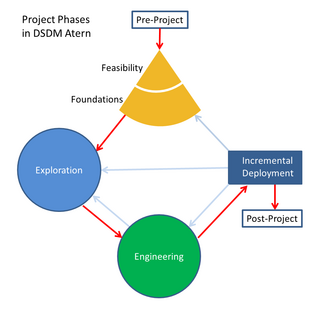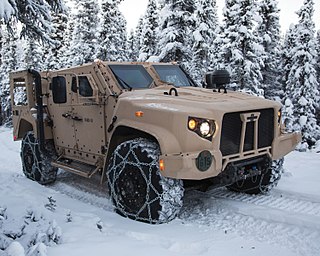Related Research Articles

Skynet is a family of military communications satellites, now operated by Babcock International on behalf of the United Kingdom's Ministry of Defence (MoD). They provide strategic and tactical communication services to the branches of the British Armed Forces, the British intelligence agencies, some UK government departments and agencies, and to allied governments. Since 2015 when Skynet coverage was extended eastward, and in conjunction with an Anik G1 satellite module over America, Skynet offers near global coverage.

The Meteor is a European active radar guided beyond-visual-range air-to-air missile (BVRAAM) developed and manufactured by MBDA. It offers a multi-shot capability, and has the ability to engage highly maneuverable targets such as jet aircraft, and small targets such as UAVs and cruise missiles in a heavy electronic countermeasures (ECM) environment with a range far in excess of 200 kilometres (110 nmi).
The Future Integrated Soldier Technology sometimes incorrectly referred to as the Future Infantry System Technology or Future Infantry Soldier Technology is a project by the British Army, which aims to enhance the infantry's combat effectiveness in the 21st century as part of the Future Soldier project. The contract was awarded to Thales in March 2003.

The Boxer is a multirole armoured fighting vehicle designed by an international consortium to accomplish a number of operations through the use of installable mission modules. The governments participating in the Boxer programme have changed as the programme has developed. The Boxer vehicle is produced by the ARTEC GmbH industrial group, and the programme is being managed by OCCAR. ARTEC GmbH is based in Munich; its parent companies are Krauss-Maffei Wegmann GmbH and Rheinmetall Military Vehicles GmbH on the German side, and Rheinmetall Defence Nederland B.V. for the Netherlands. Overall, Rheinmetall has a 64% stake in the joint venture.

Dynamic systems development method (DSDM) is an agile project delivery framework, initially used as a software development method. First released in 1994, DSDM originally sought to provide some discipline to the rapid application development (RAD) method. In later versions the DSDM Agile Project Framework was revised and became a generic approach to project management and solution delivery rather than being focused specifically on software development and code creation and could be used for non-IT projects. The DSDM Agile Project Framework covers a wide range of activities across the whole project lifecycle and includes strong foundations and governance, which set it apart from some other Agile methods. The DSDM Agile Project Framework is an iterative and incremental approach that embraces principles of Agile development, including continuous user/customer involvement.
The Future Rapid Effect System (FRES) was the name for the British Ministry of Defence (MOD) programme to deliver a fleet of more than 4,000 armoured fighting vehicles for the British Army. The vehicles were to be rapidly deployable, network-enabled, capable of operating across the spectrum of operations, and protected against current threats. The programme has now been split into two separate procurement projects for a reconnaissance Specialist Vehicle (SV) and an aspiration for a future Utility Vehicle (UV). The General Dynamics Ajax was selected to fulfill the SV requirement in 2016.

The Joint Tactical Radio System (JTRS) aimed to replace existing radios in the American military with a single set of software-defined radios that could have new frequencies and modes (“waveforms”) added via upload, instead of requiring multiple radio types in ground vehicles, and using circuit board swaps in order to upgrade. JTRS has seen cost overruns and full program restructurings, along with cancellation of some parts of the program.

The Thales Watchkeeper WK450 is an unmanned aerial vehicle (UAV) for all weather, intelligence, surveillance, target acquisition, and reconnaissance (ISTAR) used by the British Army. It is provided under an £800 million contract with UAV Tactical Systems (U-TacS), a joint venture of Elbit and Thales UK, and is based on Elbit's Hermes 450.
Bowman is the name of the tactical communications system used by the British Armed Forces.

The Joint Light Tactical Vehicle (JLTV) is a U.S. Army, U.S. Marine Corps and Special Operations Command program to partially replace the Humvee fleet with a family of more survivable vehicles having a greater payload. Early studies for the JLTV program were approved in 2006. The JLTV program incorporates lessons learned from the earlier Future Tactical Truck Systems program and other associated efforts.

Defence Equipment and Support (DE&S) is a trading entity and joint-defence organisation within the UK Ministry of Defence. It began operating on 2 April 2007, following the merger of the MoD's Defence Procurement Agency and the Defence Logistics Organisation, under the Chief Executive Officer of Defence Equipment and Support.
The British Armed Forces operates a wide range of communications and information systems. Some of these are specialised military systems, while others are procured off-the-shelf. They fall into three main categories: satellite ground terminals, terrestrial trunk communications systems, and combat net radio systems. Every part of the Army and the uses combat net radio, but only the Royal Corps of Signals and the Royal Air Force operates trunk systems and multi-channel satellite communications.

The AgustaWestland AW159 Wildcat is a military helicopter, developed by the British-Italian helicopter manufacturer AgustaWestland, and later marketed by the Italian aerospace company Leonardo. It is an improved version of the Westland Super Lynx designed to serve in the battlefield utility, search and rescue, aerial reconnaissance, anti-submarine warfare (ASW), anti-surface warfare (ASuW), utility, command and control, and troop transport duties.
General Dynamics Mission Systems is a business unit of American defense and aerospace company General Dynamics. General Dynamics Mission Systems integrates secure communication and information systems and technology. General Dynamics Mission Systems has core manufacturing in secure communications networks; radios and satellite technology for the defense, cyber, public safety, and intelligence communities.
F/A-XX is a development and acquisition program for a future sixth-generation air superiority fighter to replace the United States Navy's F/A-18E/F Super Hornet and complement the F-35C beginning in the 2030s. A requirement was first identified in June 2008.

The Ajax, formerly known as the Scout SV, is a group of armoured fighting vehicles being developed by General Dynamics UK for the British Army. It has suffered serious development and production difficulties.
The Iris Digital Communications System, also known as the Tactical Command, Control, and Communications System (TCCCS), is a tactical communication system used by the Canadian Army. It was a pioneering system that integrated voice and data communications via the Internet Protocol and ST-II protocol. Elements of the Iris system, together with the High-capacity data radio, later formed the foundation of the British Army's Bowman communications system.
General Dynamics UK is a British subsidiary of the American defence and security corporation General Dynamics. Founded in London in 1962, the company has grown to include eight sites across the United Kingdom, including in Bristol, Chippenham, Hastings, Merthyr Tydfil, Oakdale and Rotherham. Specialising in armoured fighting vehicles, avionic systems and tactical communications, the company has produced the General Dynamics Ajax armoured fighting vehicle, the Ocelot light protected patrol vehicle and the Bowman communications system. It is one of the UK's leading defence companies and a key supplier to the UK Ministry of Defence.
References
- ↑ "DELIVERY OF TACTICAL COMMUNICATIONS IN THE 21ST CENTURY, Presentation of the UK Royal Signals Institution" (PDF). Archived from the original (PDF) on 12 November 2020.
- 1 2 3 4 5 "Morpheus Project: next generation tactical communication information systems for defence". 1 August 2016. Retrieved 21 June 2017.
- ↑ "BATCIS – MORPHEUS Systems House Industry Day". Defence Contracts Online. 19 January 2015. Retrieved 30 June 2017.
- 1 2 "General Dynamics UK Awarded £330 Million Contract To Develop Next-Generation Battlefield Network For British Army". 6 April 2017. Retrieved 21 June 2017.
- ↑ "Morpheus DaaP Industry Day". TechUK. 26 July 2016. Retrieved 27 June 2017.
- ↑ "UK government ends battlefield radio contract with General Dynamics". FT. 14 December 2023.